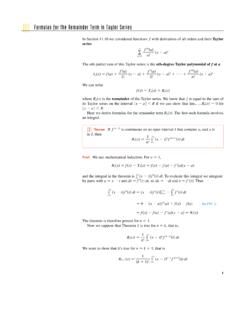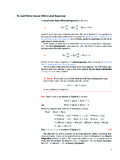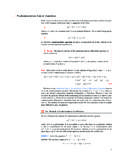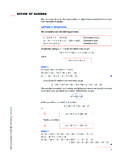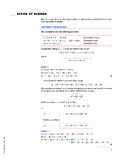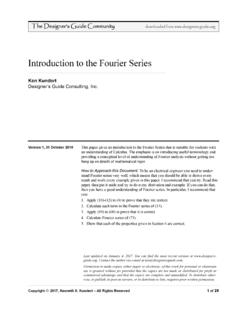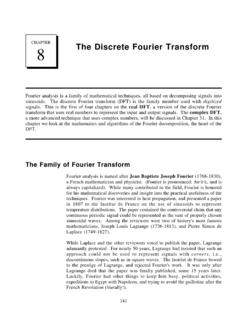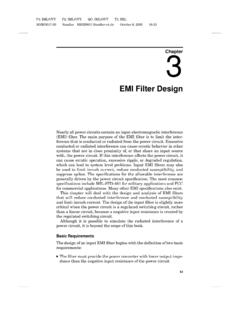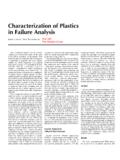Transcription of Fourier Series - Stewart Calculus
1 |||| Fourier SeriesWhen the French mathematician Joseph Fourier (1768 1830) was trying to solve a prob-lem in heat conduction, he needed to express a function as an infinite Series of sine andcosine functions:Earlier, Daniel Bernoulli and Leonard Euler had used such Series while investigating prob-lems concerning vibrating strings and Series in Equation 1 is called a trigonometric seriesor Fourier seriesand it turnsout that expressing a function as a Fourier Series is sometimes more advantageous thanexpanding it as a power Series .
2 In particular, astronomical phenomena are usually periodic,as are heartbeats, tides, and vibrating strings, so it makes sense to express them in termsof periodic start by assuming that the trigonometric Series converges and has a continuous func-tion as its sum on the interval , that is,Our aim is to find formulas for the coefficients and in terms of . Recall that for apower Series we found a formula for the coefficients in terms of deriv-atives: . Here we use we integrate both sides of Equation 2 and assume that it s permissible to integrate theseries term-by-term, we getButbecause is an integer.
3 Similarly, . Soy f x dx 2 a0x sin nx dx 0ny cos nx dx 1n sin nx 1n sin n sin n 0 2 a0 n 1 an y cos nx dx n 1 bn y sin nx dxy f x dx y a0 dx y n 1 an cos nx bn sin nx dxcn f n a n!f x cn x a nfbnan x f x a0 n 1 an cos nx bn sin nx 2 , f x b1 sin x b2 sin 2x b3 sin 3x a0 a1 cos x a2 cos 2x a3 cos 3x f x a0 n 1 an cos nx bn sin nx 1f1and solving for givesTo determine for we multiply both sides of Equation 2 by (where isan integer and ) and integrate term-by-term from to :We ve seen that the first integral is 0.
4 With the help of Formulas 81, 80, and 64 in the Tableof Integrals, it s not hard to show thatfor all and So the only nonzero term in (4) is and we getSolving for , and then replacing by , we haveSimilarly, if we multiply both sides of Equation 2 by and integrate from to ,we getWe have derived Formulas 3, 5, and 6 assuming is a continuous function such thatEquation 2 holds and for which the term-by-term integration is legitimate. But we can stillconsider the Fourier Series of a wider class of functions: A piecewise continuous functionon is continuous except perhaps for a finite number of removable or jump disconti-nuities.
5 (In other words, the function has no infinite discontinuities. See Section for adiscussion of the different types of discontinuities.) a, b fn 1, 2, 3, ..bn 1 y f x sin nx dx6 sin mxn 1, 2, 3, ..an 1 y f x cos nx dx5nmamy f x cos mx dx am am y cos nx cos mx dx 0 for n mfor n mmny sin nx cos mx dx 0 a0 y cos mx dx n 1 an y cos nx cos mx dx n 1 bn y sin nx cos mx dx4y f x cos mx dx y a0 n 1 an cos nx bn sin nx cos mx dx m 1mcos mxn 1ana0 12 y f x dx3a02 Fourier Series ||||Notice that is the average value of overthe interval.
6 , fa0 DefinitionLet be a piecewise continuous function on . Then theFourier seriesof is the serieswhere the coefficients and in this Series are defined byand are called the Fourier coefficientsof .Notice in Definition 7 that we are notsaying is equal to its Fourier Series . Later wewill discuss conditions under which that is actually true. For now we are just saying thatassociated withany piecewise continuous function on is a certain Series calleda Fourier 1 Find the Fourier coefficients and Fourier Series of the square-wave functiondefined byandSo is periodic with period and its graph is shown in Figure the formulas for the Fourier coefficients in Definition 7, we havea0 12 y f x dx 12 y0 0 dx 12 y 0 1 dx 0 12 120 FIGURE 1 Square-wave function(a) 2 _ 1yx0 2 _ 1yx(b)
7 2 ff x 2 f x f x 01if x 0if 0 x f , ff x fbn 1 y f x sin nx dxan 1 y f x cos nx dxa0 12 y f x dxbnana0 n 1 an cos nx bn sin nx f , f7 Fourier Series 3||||Engineers use the square-wave function indescribing forces acting on a mechanical systemand electromotive forces in an electric circuit(when a switch is turned on and off repeatedly).Strictly speaking, the graph of is as shown in Figure 1(a), but it s often represented as in Figure 1(b), where you can see why it s called asquare , for ,The Fourier Series of is thereforeSince odd integers can be written as , where is an integer, we can write theFourier Series in sigma notation asIn Example 1 we found the Fourier Series of the square-wave function, but we don tknow yet whether this function is equal to its Fourier Series .
8 Let s investigate this questiongraphically. Figure 2 shows the graphs of some of the partial sumswhen is odd, together with the graph of the square-wave x 12 2 sin x 23 sin 3x 2n sin nx12 k 1 2 2k 1 sin 2k 1 xkn 2k 1 12 2 sin x 23 sin 3x 25 sin 5x 27 sin 7x 2 sin x 0 sin 2x 23 sin 3x 0 sin 4x 25 sin 5x 12 0 0 0 b1 sin x b2 sin 2x b3 sin 3x a0 a1 cos x a2 cos 2x a3 cos 3x f 02n if n is evenif n is odd 1 cos nxn 0 1n cos n cos 0 bn 1 y f x sin nx dx 1 y0 0 dx 1 y 0 sin x dx 0 1 sin nxn 0 1n sin n sin 0 0an 1 y f x cos nx dx 1 y0 0 dx 1 y 0 cos nx dxn 14 Fourier
9 Series ||||Note that equals 1 if is even and if is 1ncos n We see that, as increases, becomes a better approximation to the square-wavefunction. It appears that the graph of is approaching the graph of , except whereor is an integer multiple of . In other words, it looks as if is equal to the sumof its Fourier Series except at the points where is following theorem, which we state without proof, says that this is typical of theFourier Series of piecewise continuous functions.
10 Recall that a piecewise continuous func-tion has only a finite number of jump discontinuities on . At a number where has a jump discontinuity, the one-sided limits exist and we use the notationFourier Convergence TheoremIf is a periodic function with period and andare piecewise continuous on , then the Fourier Series (7) is sum of the Fourier Series is equal to at all numbers where is continu-ous. At the numbers where is discontinuous, the sum of the Fourier Series isthe average of the right and left limits, that isIf we apply the Fourier Convergence Theorem to the square-wave function inExample 1, we get what we guessed from the graphs.

